You’ll transform your patio into a peaceful retreat by strategically combining different plant varieties that serve multiple purposes. From towering bamboo screens that create 8-10 foot privacy barriers to compact succulent gardens requiring just 4-6 hours of sunlight, each plant selection offers unique benefits for your outdoor space. Whether you’re seeking shade, fragrance, or visual appeal, these nine plant ideas will help you design a personalized sanctuary that works in harmony with your climate zone and maintenance preferences.
Contents
Lush Hanging Ferns for Natural Shade
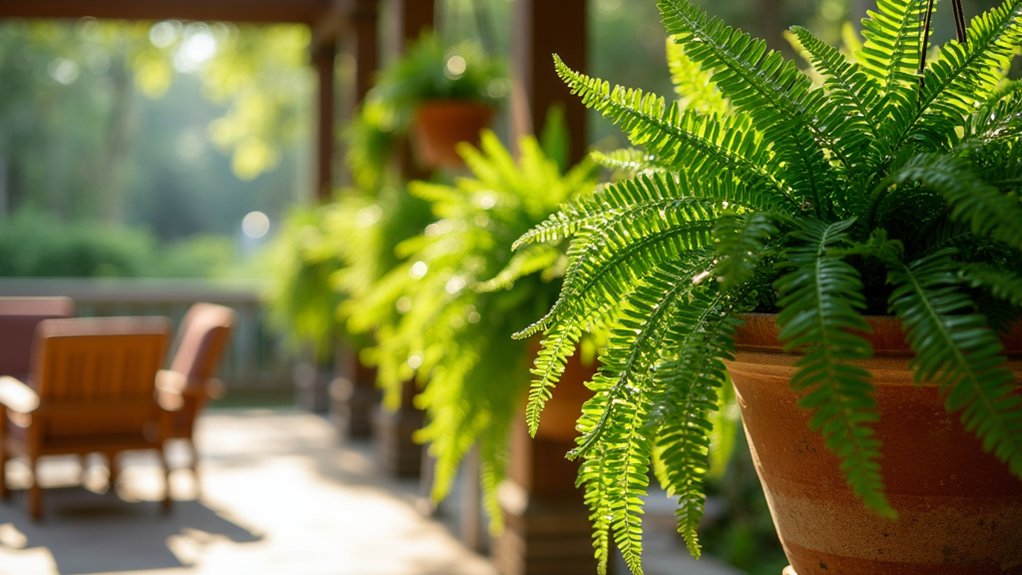
Hanging ferns create a dramatic cascading effect on patios, with their abundant fronds forming natural curtains of lush greenery. Boston ferns, Maidenhair ferns, and Bird’s Nest ferns are particularly well-suited for outdoor patio spaces, featuring delicate, arching fronds that can span 2-3 feet in length.
These versatile plants not only provide natural shade but also add a tropical atmosphere while helping to filter air and increase humidity in their immediate surroundings.
Growing Conditions:
- Bright, indirect light – avoid direct afternoon sun
- Consistently moist soil, never allowing it to completely dry out
- Well-draining potting mix rich in organic matter
- Humidity levels of 50% or higher
- Temperature range between 60-75°F (15-24°C)
- Protected location away from strong winds
- Regular fertilization during growing season with balanced, water-soluble fertilizer
Regular grooming is essential for maintaining healthy hanging ferns. Remove any yellowed or brown fronds at the base to encourage new growth and maintain appearance.
Rotate hanging baskets weekly to ensure even growth, and mist the plants regularly during dry periods. During hot summer months, consider moving ferns to a shadier spot and increase watering frequency.
Inspect regularly for pests like scale or mealybugs, treating any issues promptly with insecticidal soap to prevent infestation spread.
Colorful Lavender and Other Aromatic Herbs
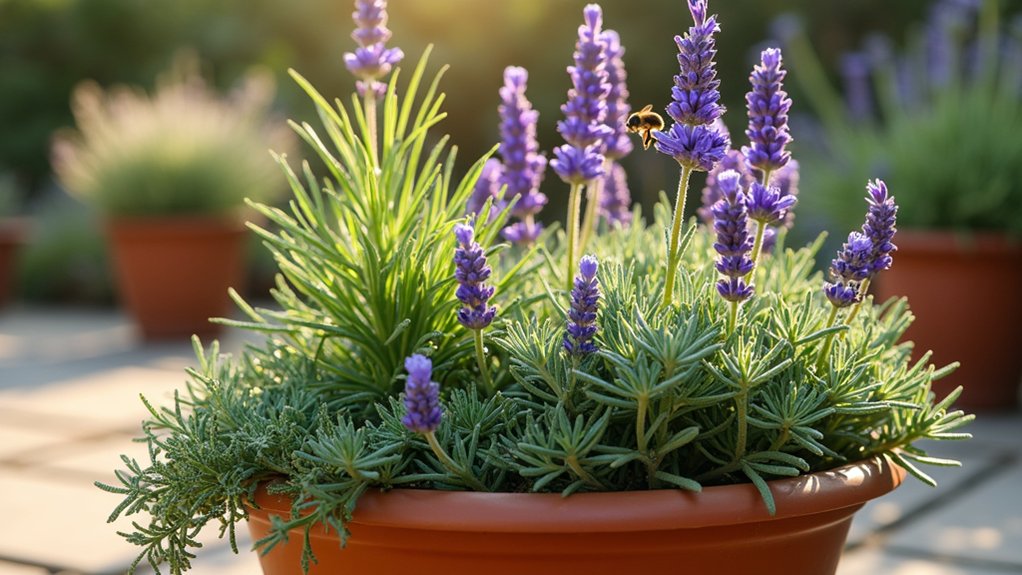
Lavender and aromatic herbs bring both visual appeal and delightful fragrances to outdoor patios, creating a multi-sensory garden experience. Lavender‘s signature purple-blue spikes rise above silvery-green foliage, while other aromatic herbs like rosemary, thyme, and sage offer varying shades of green and different textural elements.
These plants not only provide ornamental value but also serve practical purposes in cooking and natural aromatherapy, while attracting beneficial pollinators to your patio space.
- Full sun exposure (6-8 hours daily)
- Well-draining soil with pH 6.5-7.5
- Moderate watering; allow soil to dry between waterings
- Terra cotta or clay pots with drainage holes
- Space plants 12-18 inches apart
- Mediterranean-like conditions with good air circulation
- Sandy or gravelly soil mix
- Protection from harsh winds
Regular pruning and deadheading are essential for maintaining healthy aromatic herbs and encouraging bushier growth. Trim lavender stems back by one-third after the first bloom to promote a second flowering, and shape other herbs frequently to prevent them from becoming woody or leggy.
Remove any yellowing leaves promptly to prevent fungal issues, and avoid over-fertilizing as most aromatic herbs prefer lean soil conditions. During winter months, reduce watering frequency and consider moving containers to a protected area if temperatures drop below freezing.
Cascading Potted Petunias
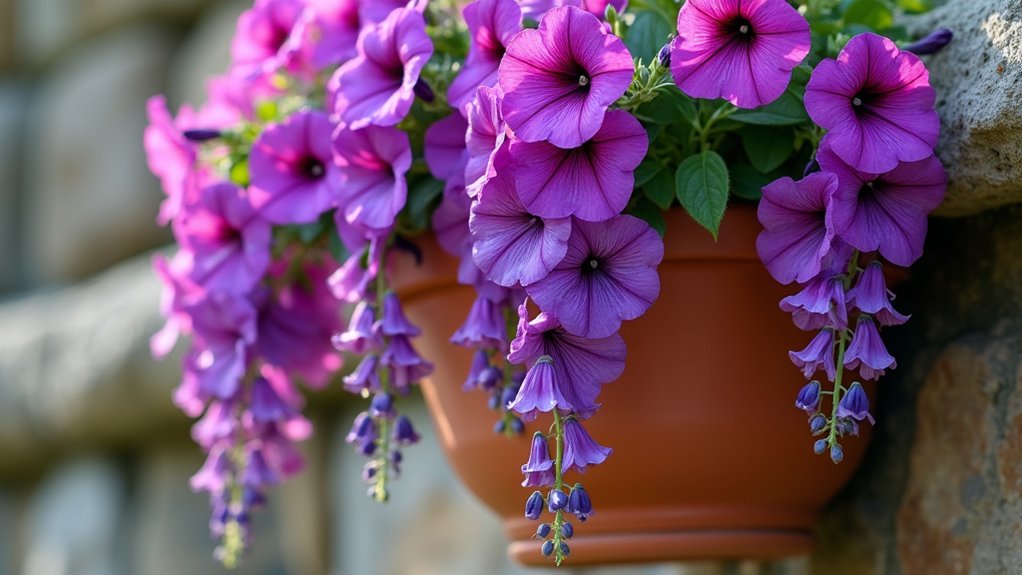
Cascading potted petunias create stunning visual displays with their abundant, trumpet-shaped blooms that spill gracefully over the edges of containers and hanging baskets.
These prolific flowering plants produce masses of colorful blossoms in shades of purple, pink, white, red, and bi-color varieties, creating dramatic curtains of flowers that can trail up to 3 feet in length. Their trailing habit makes them perfect for elevated planters, window boxes, and hanging arrangements on patios where their flowing growth can be fully appreciated.
- Light: Full sun (6-8 hours daily); morning sun with afternoon shade in hot climates
- Water: Keep soil consistently moist but not waterlogged; water when top inch of soil feels dry
- Soil: Well-draining, fertile potting mix with added organic matter
- Temperature: 60-75°F (16-24°C)
- Container: Minimum 12-inch diameter with adequate drainage holes
- Fertilizer: Monthly feeding with balanced, water-soluble fertilizer
- Spacing: 12 inches between plants in containers
Regular deadheading of spent blooms encourages continuous flowering throughout the growing season and prevents the plants from becoming leggy.
Pinching back long stems by about one-third of their length every few weeks promotes bushier growth and more abundant flowering. During periods of intense heat, providing afternoon shade and increasing watering frequency helps prevent flower drop and maintains the plant’s vigorous blooming cycle.
Trim any yellowing or damaged foliage promptly to maintain the plant’s attractive appearance and prevent potential disease issues.
Hardy Bamboo Screens
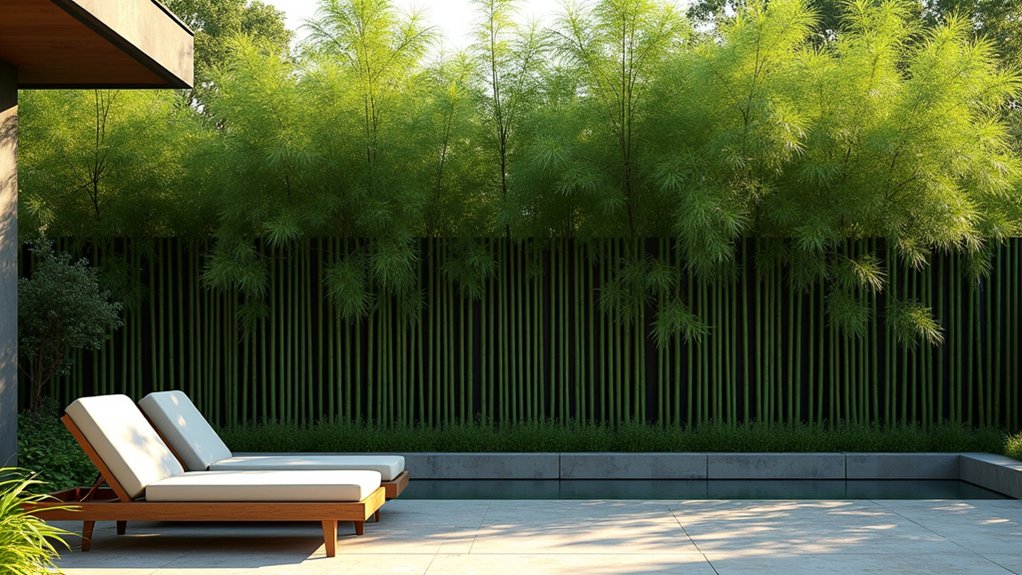
Hardy bamboo screens create natural, elegant privacy barriers for patios while adding a striking vertical element to outdoor spaces. These dense, evergreen plants feature tall, sturdy culms (stems) that grow closely together, forming living walls that can reach heights of 10-30 feet depending on the variety. The slender leaves rustle pleasantly in the breeze, adding both movement and gentle sound to the garden environment.
- Light: Prefers full sun to partial shade; morning sun with afternoon shade is ideal
- Water: Regular, deep watering; moist but well-draining soil
- Soil: Rich, fertile, slightly acidic soil with pH 6.0-6.5
- Temperature: Most hardy varieties tolerate temperatures down to -10°F
- Spacing: Plant 3-5 feet apart for dense screening
- Growth Zone: USDA zones 5-10, depending on variety
Successful bamboo screen maintenance requires regular attention to spreading, as many varieties are aggressive growers. Install root barriers at planting time, extending at least 2 feet deep into the soil.
Prune dead or damaged culms at ground level in early spring, and remove any wayward shoots that emerge outside desired growth areas. Annual topdressing with composted organic matter helps maintain soil fertility, while periodic thinning of older culms promotes healthy new growth and maintains the screen’s aesthetic appeal.
Low-Maintenance Succulent Gardens
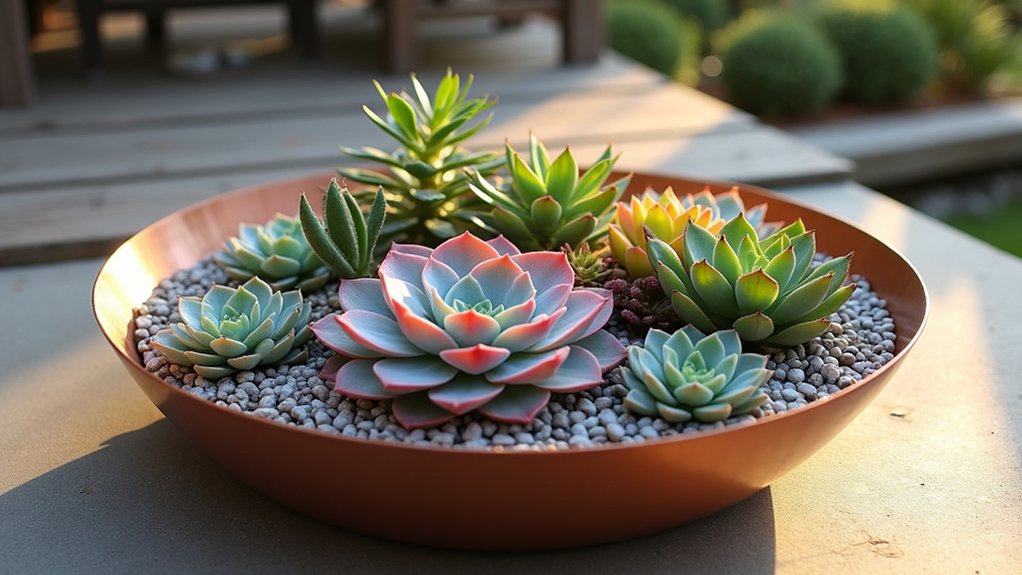
Low-maintenance succulent gardens transform outdoor patios into striking desert-inspired displays featuring plants with thick, fleshy leaves arranged in captivating geometric patterns.
These versatile gardens can include a mix of varieties like Echeveria, Sedum, and Sempervivum, creating a tapestry of colors from soft blues and greens to vivid purples and reds.
Whether planted in containers, wall-mounted planters, or rock gardens, succulents offer architectural interest and drought-resistant beauty with minimal care requirements.
- Full sun to partial shade, with morning sun and afternoon shade ideal in hot climates
- Well-draining soil specifically formulated for succulents and cacti
- Water deeply but infrequently, allowing soil to dry completely between waterings
- Temperature range of 40-80°F (4-27°C), with protection from frost
- Container or ground planting with excellent drainage and air circulation
- Gritty soil mix with added perlite, coarse sand, or pumice
Regular maintenance for succulent gardens focuses on preventing common issues rather than constant care.
Remove any dead or yellowing leaves promptly to prevent pest problems, and trim overgrown plants to maintain desired shape and prevent overcrowding.
During the growing season, apply a diluted cactus fertilizer every few months, and relocate containers if needed to protect from excessive rainfall or harsh afternoon sun.
Winter care involves reducing watering frequency and moving vulnerable varieties to sheltered locations if temperatures drop below freezing.
Climbing Jasmine and Fragrant Vines
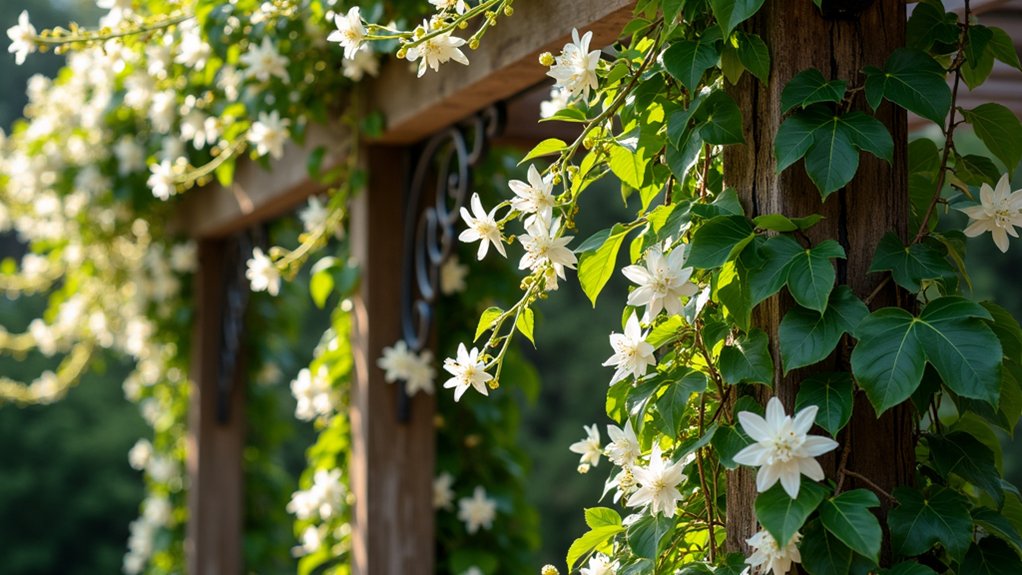
Climbing jasmine and fragrant vines are enchanting additions to any patio space, creating living walls of delicate blooms and intoxicating scents. These versatile climbers, including varieties like Star Jasmine and Confederate Jasmine, produce clusters of white, pink, or yellow star-shaped flowers against glossy evergreen foliage.
The vines can gracefully cover trellises, pergolas, and walls, reaching heights of 20-30 feet while releasing their sweet fragrance, particularly noticeable during evening hours.
- Light: Partial to full sun, with morning sun and afternoon shade ideal for most varieties
- Soil: Well-draining, rich organic soil with pH between 6.0-7.0
- Water: Regular watering to maintain consistently moist soil, not waterlogged
- Temperature: Most varieties thrive in zones 7-10, protected from harsh winds
- Spacing: Plant 3-6 feet apart to allow proper growth and air circulation
- Support: Requires sturdy trellis, wire, or lattice system for climbing
Regular maintenance is crucial for keeping climbing jasmine and fragrant vines healthy and controlled.
Prune after the main flowering period to maintain shape and encourage bushier growth, removing dead or tangled stems. Train new growth by gently weaving stems through support structures or tying them with soft plant ties.
Monthly feeding during the growing season with a balanced fertilizer promotes continuous blooming, while mulching around the base helps retain moisture and suppress weeds.
Ornamental Grasses for Movement
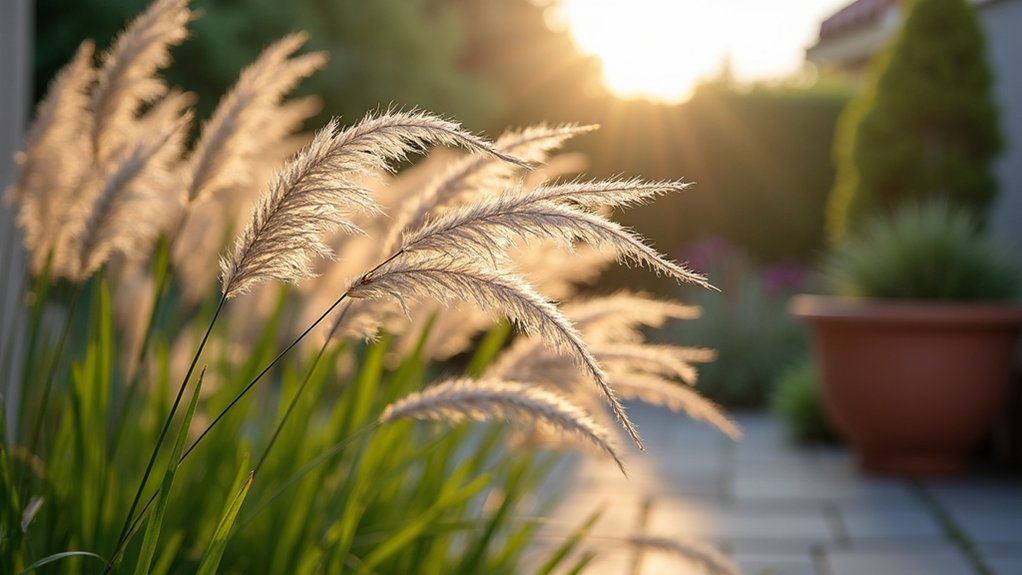
Ornamental grasses bring dynamic movement and visual interest to patio spaces, swaying gracefully in the breeze and creating a natural, flowing aesthetic.
These grasses range from compact varieties like Blue Fescue to towering specimens like Maiden Grass, offering various heights, colors, and textures. Many ornamental grasses also provide year-round interest, transitioning from lush green in spring to golden hues in fall, with striking seed heads that persist through winter.
Growing Conditions:
- Full sun to partial shade, with most varieties preferring 6+ hours of direct sunlight
- Well-draining soil with moderate fertility
- Moderate watering needs; established plants are drought-tolerant
- Spacing of 2-4 feet between plants, depending on variety
- USDA hardiness zones 4-9 for most varieties
- Tolerant of various soil pH levels (5.5-7.5)
Regular maintenance keeps ornamental grasses looking their best throughout the seasons.
Cut back deciduous varieties to 4-6 inches above ground in late winter or early spring before new growth emerges. Remove dead foliage and divide clumps every 3-4 years when they become too dense or show signs of dying in the center.
Avoid over-fertilizing, as this can lead to excessive growth and flopping. Trim brown tips as needed during the growing season, and remove any seed heads before they spread if self-seeding is undesirable.
Container-Grown Citrus Trees
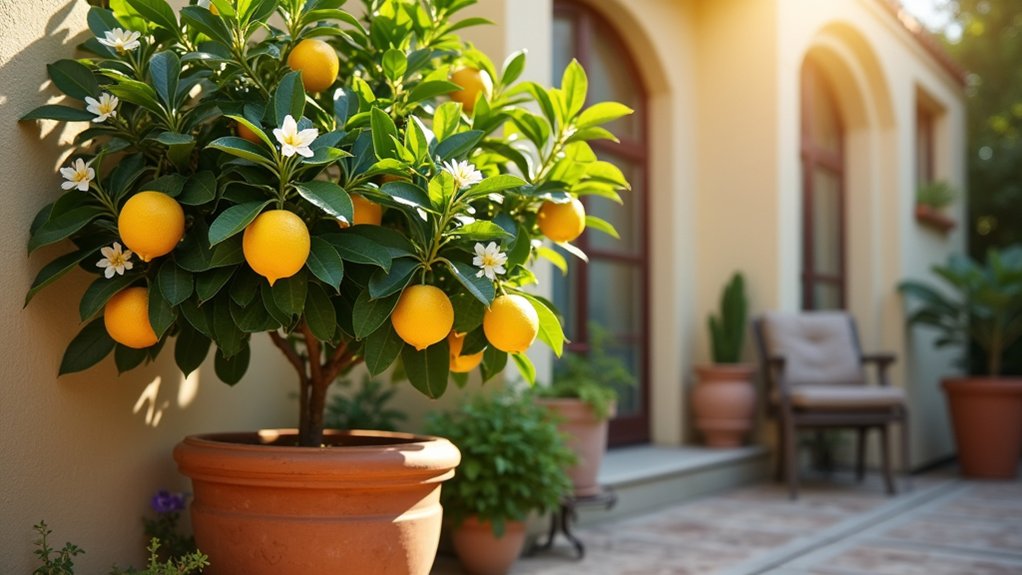
Container-grown citrus trees bring a touch of the Mediterranean to any patio space, offering both ornamental beauty and edible fruit. These compact versions of orchard trees typically grow 4-8 feet tall in containers, featuring glossy evergreen foliage, fragrant white blossoms, and colorful fruits that can include lemons, limes, oranges, or kumquats.
The combination of decorative foliage, sweet-smelling flowers, and vibrant fruits makes them excellent focal points for outdoor living spaces.
- Full sun required (6-8 hours daily)
- Well-draining potting mix specifically formulated for citrus
- Consistent moisture but never waterlogged
- Temperature range of 55-85°F (12-29°C)
- Container size minimum of 15-20 gallons
- Monthly feeding with citrus-specific fertilizer during growing season
- Humidity levels above 50%
- Protection from strong winds
Regular pruning to maintain shape and size is essential for container citrus, along with monitoring for pests like spider mites and scale insects.
Move containers indoors when temperatures drop below 50°F (10°C), and periodically clean the leaves with a damp cloth to remove dust and maintain photosynthesis efficiency.
Root pruning every 3-4 years helps prevent the tree from becoming rootbound and ensures continued healthy growth in the confined space of a container.
Seasonal Blooming Perennials
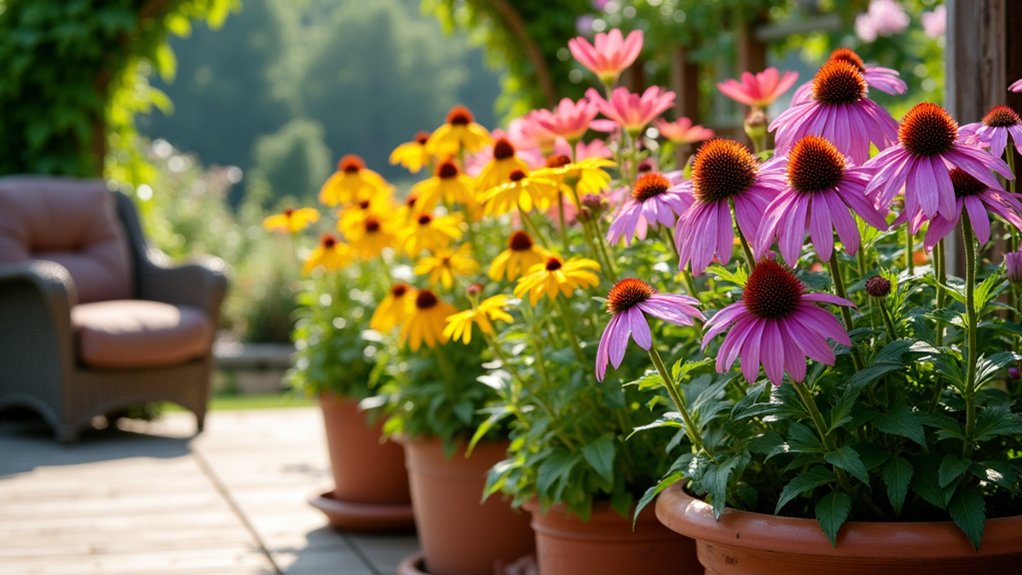
Seasonal blooming perennials provide continuous color and interest to outdoor patios throughout multiple growing seasons, returning year after year.
These plants transition through distinct blooming periods, with some varieties flowering in spring, others in summer, and some lasting into fall. Popular options include daylilies, coneflowers, black-eyed susans, and salvias, offering a diverse palette of colors, heights, and textures that can be strategically combined to ensure ongoing visual appeal.
- Light Requirements: Most seasonal perennials need 6-8 hours of direct sunlight daily, though some varieties tolerate partial shade
- Water Needs: Moderate watering, allowing soil to dry slightly between waterings
- Soil Type: Well-draining, fertile soil rich in organic matter
- pH Level: 6.0-7.0 for most varieties
- Temperature Range: Hardy in zones 4-9, depending on specific variety
- Container Size: Minimum 12-inch depth with adequate drainage holes
- Spacing: 12-18 inches between plants in containers
To maintain healthy seasonal blooming perennials, implement a regular deadheading schedule to encourage continuous blooming and prevent seed formation.
Divide overcrowded plants every 3-4 years in early spring or fall to maintain vigor and promote better air circulation.
Apply a slow-release fertilizer at the beginning of the growing season and trim back spent foliage in late fall or early spring before new growth emerges.
During winter months in colder regions, protect container-grown perennials by moving them to a sheltered location or adding mulch around the base.
